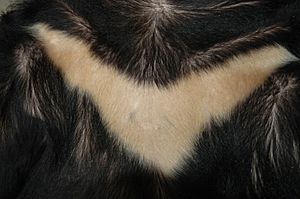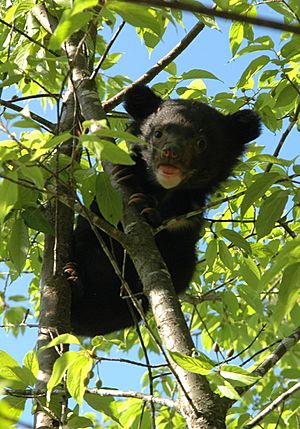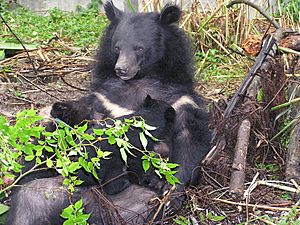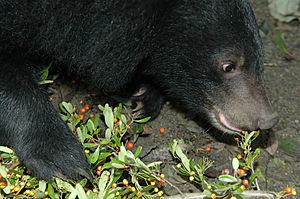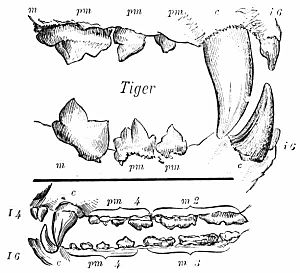Asian black bear facts for kids
The Asian black bear (Ursus thibetanus), also known as the Asiatic black bear or Moon bear, is a medium-sized bear. It has black fur and a special white or cream "V" shape on its chest.
This bear is a close relative of the American black bear. Scientists believe they both came from a common ancestor in Europe. In Korea, it's called bandalgaseumgom, which means "half-moon chest bear." These two bear species are more closely related to each other than to any other type of bear.
Quick facts for kids Asian black bear |
|
|---|---|
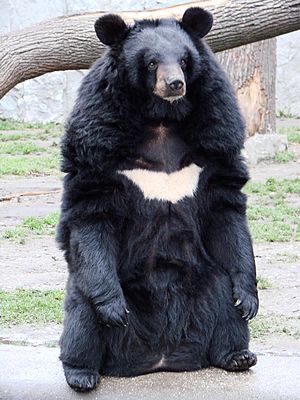 |
|
| Conservation status | |
| Scientific classification | |
| Genus: |
Ursus
|
| Species: |
thibetanus
|
| Subspecies | |
|
7, see text |
|
 |
|
| Asian black bear range (brown – extant, black – extinct, dark grey – presence uncertain) |
|
| Synonyms | |
|
Selenarctos thibetanus |
|
Contents
What Asian Black Bears Look Like
Asian black bears are black with a light brown snout. They have a white chin and a clear white patch on their chest, often shaped like a "V." Their ears are bell-shaped and stick out sideways. Their tail is about 11 cm (4.3 in) long.
Adult bears stand 70 to 100 cm (28 to 39 in) tall at the shoulder. They are 120 to 190 cm (47 to 75 in) long. Adult males usually weigh around 135 kg (298 lb), but can be from 60 to 200 kg (130 to 440 lb). Females weigh 40 to 125 kg (88 to 276 lb). Some large females can reach 140 kg (310 lb).
These bears look a bit like brown bears. However, Asian black bears are lighter and have thinner legs. Their lips and nose are bigger and can move more than a brown bear's.
Asian black bears have strong upper bodies. This helps them climb trees very well. Their back legs are weaker and shorter than those of brown bears and American black bears. They are known to walk on two legs more often than other bears, sometimes for long distances. Their claws are longer on their front paws, which helps them climb and dig.
Their eyesight is not very good. Their hearing is moderate, meaning they can hear some sounds well but not all.
How Asian Black Bears Behave
Asian black bears are usually active during the day. However, near people, they might become active at night. They sometimes live in family groups. These groups can have two adults and two sets of young bears. They often walk in a line, from the biggest to the smallest.
They are excellent climbers of rocks and trees. They climb to find food, rest, sunbathe, escape enemies, and even to hibernate. Older, heavier bears might find it harder to climb. They spend about half their lives in trees. They are among the largest mammals that live in trees.
When eating in trees, they break branches and twigs. They place these under themselves to make a kind of nest. This is why many trees in their areas have nest-like shapes at the top. They also rest in these tree nests for short periods, often fifteen feet or higher off the ground.
Asian black bears do not hibernate in all parts of their range. In colder, northern areas, they do hibernate. Some bears simply move to lower, warmer places. Almost all pregnant females hibernate. Bears get their dens ready in mid-October and sleep from November to March. Their dens can be hollow trees, caves, holes in the ground, or even old brown bear dens.
Black bears have many different sounds. They grunt, whine, roar, and make slurping sounds when eating. They make loud hisses as warnings and scream when fighting. When they approach other bears, they make "tut tut" sounds by snapping their tongue. When looking for a mate, they make clucking sounds.
Reproduction and Life Cycle
In some areas, black bears breed from mid-June to mid-August. Births happen earlier, in mid-January. Females usually have their first babies when they are three years old.
Like brown bears, Asian black bears have something called "delayed implantation." This means the fertilized egg doesn't attach to the womb right away. Females usually give birth in caves or hollow trees in winter or early spring. The pregnancy lasts about 200 to 240 days.
Cubs weigh about 13 ounces (370 grams) at birth. They start walking at four days old and open their eyes three days later. A litter can have 1 to 4 cubs, but 2 is common. Cubs grow slowly, reaching only 2.5 kg (5.5 lb) by May. They nurse for a long time, from 104 to 130 weeks. They become independent when they are 24 to 36 months old. Females usually have new litters every 2 to 3 years.
In the wild, Asian black bears live for about 25 years. The oldest known Asian black bear in a zoo lived to be 44 years old.
What Asian Black Bears Eat
Asian black bears are omnivores, meaning they eat both plants and animals. They eat insects, beetle larvae, invertebrates, termites, grubs, dead animals (carrion), bees, eggs, and even garbage.
They also eat many plant foods like mushrooms, grasses, fruits, nuts, seeds, honey, herbs, acorns, cherries, dogwood, and grain.
While they eat more plants than brown bears, they are not as specialized as pandas. Pandas need a constant supply of low-calorie food. Black bears are more flexible. They eat a lot of high-calorie foods when available, storing fat. Then they hibernate when food is scarce.
They will eat pine nuts and acorns from the previous year in spring. If food is scarce, they go to river valleys to find hazelnuts and insect larvae in rotting logs. From mid-May to late June, they eat green plants and fruit. From July to September, they climb trees to eat bird cherries, pine cones, vines, and grapes.
Sometimes, they eat dead fish during spawning season. They are more carnivorous than most other bears, including American black bears. They will regularly hunt and kill hoofed animals. This can include small deer like muntjacs, serow, takin, wild boar, and even adult water buffaloes. They kill these animals by breaking their necks.
Who Hunts Asian Black Bears
Asian black bears can sometimes be attacked by tigers and brown bears. Other threats include leopards, and groups of wolves and dholes. Young cubs might be hunted by Eurasian lynxes.
Black bears usually win fights against Amur leopards in thick forests. Leopards tend to win in open areas. The winner often depends on the size of the animals. Leopards are known to hunt cubs younger than two years old.
The areas where Asian black bears live overlap with sloth bears in India, sun bears in Southeast Asia, and brown bears in Russia. Brown bears might attack black bears. However, Himalayan brown bears seem to be scared of black bears when they meet. Brown bears will eat fruit that black bears drop from trees, as they are too big to climb easily.
Tigers sometimes hunt black bears. If a black bear escapes a tiger, it will try to climb a tree and wait for the tiger to leave. Some tigers might pretend to leave and then wait for the bear to come down. Tigers often hunt young bears, but adult bears are also sometimes caught. Black bears are usually safe from tiger attacks once they are five years old.
Black bears prefer to avoid tigers. However, they can be very tough when attacked. One famous hunter saw a black bear chase off a tiger, even after the bear was badly hurt. Black bears might be safer from tigers than brown bears. This is because they often live in hollows or rocky areas, which are harder for tigers to get into. Black bears have also been known to steal food from tigers when the tiger is away.
Where Asian Black Bears Live
Asian black bears typically live in forests with deciduous trees (trees that lose their leaves), mixed forests, and thorny bush forests. They rarely live higher than 12,000 feet (3,700 meters). In the Himalayas, they usually live around 11,480 feet (3,500 meters) in summer. In winter, they move down to about 4,920 feet (1,500 meters). In Japan, they can sometimes be found at sea level.
Fossils show that black bears once lived as far west as Germany and France. Today, they are found in patches across Asia. Their range goes from southeastern Iran eastward through Afghanistan and Pakistan. It continues across the foothills of the Himalayas in India, to Myanmar.
Except for Malaysia, black bears live in all countries in mainland Southeast Asia. They are not found in much of east-central China. However, they live in some parts of southern and northeastern China. Other groups of bears live in the southern Russian Far East and into North Korea. South Korea has a small remaining population. Black bears also live on Japan's islands of Honshu and Shikoku, and on Taiwan and Hainan.
It's hard to know exactly how many Asian black bears there are. Japan estimated 8,000 to 14,000 bears on Honshu, but this is now questioned. Russian scientists estimated 5,000 to 6,000 bears across their range. In 2012, Japan's Ministry of the Environment estimated 15,000 to 20,000 bears. Rough estimates in India and Pakistan suggest 7,000 to 9,000 in India and 1,000 in Pakistan. China's estimates vary, from 15,000 to 46,000, with a government estimate of 28,000.
Images for kids
-
Kintoki Wrestling with a Black Bear, woodblock print by Torii Kiyomasu I, c. 1700, Honolulu Academy of Arts
-
A trio of captive Asian black bears around their keeper in Florence
-
An Asian black bear hunt, as illustrated by Samuel Howitt
See also
 In Spanish: Oso tibetano para niños
In Spanish: Oso tibetano para niños



